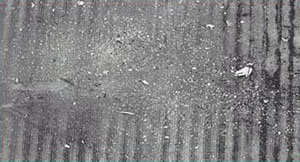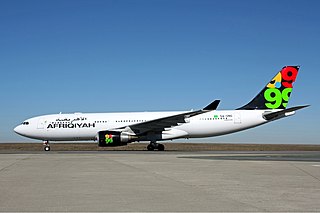
Air Florida Flight 90 was a scheduled U.S. domestic passenger flight operated by Air Florida from Washington National Airport to Fort Lauderdale–Hollywood International Airport, with an intermediate stopover at Tampa International Airport. On January 13, 1982, the Boeing 737-222 registered as N62AF crashed into the 14th Street Bridge over the Potomac River just after take off from Washington National Airport.

Scandinavian Airlines System Flight 751 was a regularly scheduled Scandinavian Airlines passenger flight from Stockholm, Sweden, to Warsaw, Poland, via Copenhagen, Denmark. On 27 December 1991, a McDonnell Douglas MD-81 operating the flight, registration OY-KHO, piloted by Danish Captain Stefan G. Rasmussen (44) and Swedish first officer Ulf Cedermark (34), both experienced pilots with 8,000 and 3,000 flight hours, respectively, was forced to make an emergency landing in a field near Gottröra, Sweden. Ice had collected on the wings' inner roots before takeoff, broke off, and was ingested into the engines as the aircraft became airborne on takeoff, ultimately disabling both engines. All 129 passengers and crew aboard survived.

USAir Flight 405 was a regularly scheduled domestic passenger flight between LaGuardia Airport in Queens, New York City, New York, and Cleveland, Ohio. On March 22, 1992, a USAir Fokker F28, registration N485US, flying the route, crashed in poor weather in a partially inverted position in Flushing Bay, shortly after liftoff from LaGuardia. The undercarriage lifted off from the runway, but the airplane failed to gain lift, flying only several meters above the ground. The aircraft then veered off the runway and hit several obstructions before coming to rest in Flushing Bay, just beyond the end of the runway. Of the 51 people on board, 27 were killed, including the captain and a member of the cabin crew.

West Caribbean Airways Flight 708 was a charter flight that crashed in northwest Venezuela in the early hours of Tuesday, 16 August 2005, killing all 160 passengers and crew on board. The plane, a McDonnell Douglas MD-82, registration HK-4374X, was en route from Tocumen International Airport (PTY) in Panama City, Panama, to Martinique Aimé Césaire International Airport (FDF) in Fort-de-France, Martinique, France. While flying at 33,000 ft (10,000 m), the aircraft's speed gradually decreased until it entered an aerodynamic stall. The crew, probably under the mistaken belief that the aircraft had suffered a double engine flameout, did not take the necessary actions to recover from the stall. The confusion and lack of action resulted in the crash.

American Eagle Flight 4184, officially operating as Simmons Airlines Flight 4184, was a scheduled domestic passenger flight from Indianapolis, Indiana, to Chicago, Illinois, United States. On October 31, 1994, the ATR 72 performing this route flew into severe icing conditions, lost control and crashed into a field. All 68 people aboard were killed in the high-speed impact.
Marsa Brega Airport is an airport serving Brega, a Mediterranean coastal port in the Al Wahat District of Libya. The airport is 3 kilometres (1.9 mi) south of the town.

Afriqiyah Airways Flight 771 was a scheduled international Afriqiyah Airways passenger flight that crashed on 12 May 2010 at about 06:01 local time on approach to Tripoli International Airport, about 1,200 metres short of the runway. Of the 104 passengers and crew on board, 103 were killed. The sole survivor was a 9-year-old Dutch boy. The crash of Flight 771 was the third hull-loss of an Airbus A330 involving fatalities, occurring eleven months after the crash of Air France Flight 447.
This is a list of aviation-related events from 2011.

On 27 July 1989, Korean Air Flight 803, a DC-10 crashed while attempting to land in Tripoli, Libya. 75 of the 199 passengers and crew on board plus 4 people on the ground were killed in the crash. The crash was the deadliest aviation disaster to occur in Libya at the time.

Palair Macedonian Airlines Flight 301 was a scheduled international passenger flight from Skopje to Zurich, operated by Palair Macedonian, the then-flag carrier of Macedonia, now called North Macedonia. On 5 March 1993, the aircraft operating the flight, a Fokker 100, crashed shortly after taking off from Skopje Airport in snowy conditions. Out of the 97 passengers and crew members on board, only 14 survived. At the time, it was the deadliest air disaster in North Macedonia.

Air Algérie Flight 5017 was a scheduled international passenger flight from Ouagadougou, Burkina Faso, to Algiers, Algeria, which crashed near Gossi, Mali, on 24 July 2014. The McDonnell Douglas MD-83 twinjet with 110 passengers and 6 crew on board, operated by Swiftair for Air Algérie, disappeared from radar about fifty minutes after take-off. There were no survivors.

Loganair Flight 670A (LC670A) was a scheduled cargo flight for the Royal Mail from Edinburgh-Turnhouse Airport, Scotland to Belfast International Airport. On 27 February 2001 the Short 360 operating the flight ditched in the Firth of Forth off Edinburgh at around 17:30 local time; the two crewmembers' bodies were found in the wreckage a few hours after the crash.

On 17 December 2012, an Antonov AN-26 cargo aircraft operated by Amazon Sky was flying from Jorge Chávez International Airport in Lima to Las Malvinas Airport in the Cuzco Province, Peru with 4 crew when it experienced a dual engine failure due to icing and crashed into mountainous terrain in the Tomas District of Yauyos Province, Peru, killing all occupants.

Aeroflot Flight 513 was a domestic scheduled passenger flight operated by Aeroflot that crashed during takeoff from Kuybyshev Airport in the Soviet Union on 8 March 1965, resulting in the deaths of 30 passengers and crew. It was the first fatal accident involving a Tupolev Tu-124.

West Wind Aviation Flight 282 was a domestic passenger flight from Fond-du-Lac Airport to Stony Rapids Airport, Canada. The aircraft was an ATR 42-320 registered C-GWEA. On 13 December 2017, shortly after taking off from Fond-du-Lac, the ATR-42 lost altitude and hit the ground. All 25 passengers and crew initially survived the crash, but one passenger later died of his injuries in hospital. Investigation on the cause of the crash determined that it was caused by ice contamination on the aircraft.

Iran Aseman Airlines Flight 3704 was a scheduled Iranian domestic passenger flight from Iranian capital Tehran Mehrabad International Airport to Yasuj in southwest Iran. On 18 February 2018, during its approach to Yasuj, the aircraft serving the flight, an ATR 72-212 operated by Iran Aseman Airlines, crashed into Mount Dena in the Zagros Mountains near Noqol village in Semirom county, Isfahan Province. All 66 people on board, including 60 passengers and 6 crew members, were killed.

TransAsia Airways Flight 791 was a regular cargo flight between Chiang Kai Shek International Airport and Macau International Airport. At 01:52 am local time on 21 December 2002, the ATR 72 operating the flight crashed into the sea 17 kilometres southwest of Magong, Penghu, Taiwan. The two crew members on board were killed.

Ryan International Airlines Flight 590 was a cargo flight carrying mail for the United States Postal Service from Greater Buffalo International Airport (BUF) in Buffalo, New York, to Indianapolis International Airport (IND) in Indiana, with a stopover at Cleveland Hopkins International Airport (CLE) in Cleveland, Ohio. On February 17, 1991, the McDonnell Douglas DC-9-15RC operating the flight crashed on takeoff from Cleveland during icing conditions. Both pilots, the aircraft's only occupants, were killed. The National Transportation Safety Board (NTSB) determined that the causes of the crash were the flight crew failing to deice their aircraft, and the inexperience of the Federal Aviation Administration (FAA), McDonnell Douglas, and Ryan International Airlines with icing condition on DC-9-10 aircraft.

Siberian Light Aviation Flight 42 was a domestic Russian scheduled passenger flight from Kedrovy to Tomsk, both in Tomsk Oblast in Siberia. On 16 July 2021, the Antonov An-28 operating the flight suffered icing in the engines leading to a dual engine failure 10 minutes into the flight and crash landed in a remote area in the Vasyugan Swamp in the Bakcharsky District. The pilot suffered a broken leg requiring surgery, but all of the remaining passengers and crew escaped with only minor injuries. An investigation ultimately concluded that the pilots of the aircraft had not activated the anti-icing system, which led to an accumulation of ice, resulting in engine failure. Initially praised as a hero for his handling of the incident, the captain of the flight was ultimately criminally charged for violating safety protocols, leading to the crash.



















